V. Catalog Generation
3. Source Selection
Flux Overestimation vs. Signal-to-Noise Ratio
i. Single Band Thresholding
A simulation was done using purely Gaussian statistics to derive the
approximate magnitude of the flux overestimation bias vs. the
photometric uncertainty,  . 11,000 sources were
generated from a population that had a log N / log S slope of
-1.5, a cutoff at signal-to-noise ratio, SNRtrue = 0.5.
This should provide accurate results for observed SNR > ~3.5. SNR was used
as a direct proxy for flux, assuming a constant noise in this simulation.
(Multiplying all SNR values by
. 11,000 sources were
generated from a population that had a log N / log S slope of
-1.5, a cutoff at signal-to-noise ratio, SNRtrue = 0.5.
This should provide accurate results for observed SNR > ~3.5. SNR was used
as a direct proxy for flux, assuming a constant noise in this simulation.
(Multiplying all SNR values by  results in the
flux, in flux units, rather than SNR units.)
results in the
flux, in flux units, rather than SNR units.)
The measured flux vs. the true flux are shown for all sources in Figure 1 and for sources with SNRtrue between 2 and 10 in Figure 2. These figures show:
- the expected Gaussian distribution, when cut at constant values of true
flux;
- a distinctly non-Gaussian distribution, when cut at constant values of
measured flux; and
- a significant number of sources observed up to SNR = 7 that actually have much lower true flux.

| 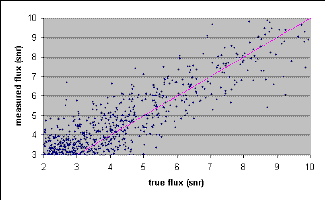 |
| Figure 1 | Figure 2 |
A histogram of the ratio of observed flux to true flux in Figure 3 shows a clear asymmetry, even in the SNR 6--7 bin, with 22% of the sources having a flux ratio above 1.3 vs. none of the sources having a flux ratio below 0.7. Even if all the sources had the highest theoretical flux uncertainties at SNR=6, the lower edge of that bin, only 3.6% of the sources should be in either tail.
Taking the ratio of the median measured flux to the median true flux in flux bins, and subtracting 1, the median flux overestimation as a function of SNR can be computed and shown in Figure 4. A clear, large mean flux overestimation of well over 5% exists below SNR = 7. Furthermore, a smooth fit to the data shows that the flux overestimation in the SNR 7--8 bin is around 5%.
Another way to look at the flux overestimation is to compute the mean flux overestimation, as a fraction of the quoted error, shown in Figure 5. The mean flux overestimation is a full 50% of the quoted flux error for SNR = 6--7, making the quoted flux errors a seriously deficient measure of the true flux accuracy.
The derived log dN / log S in Figure 6 shows the expected excess of sources, starting at SNR ~ 6 (see Figure 7).
This simulation gives minimum values for the flux overestimation. All the sources of non-Gaussian noise only increase the actual flux overestimation.
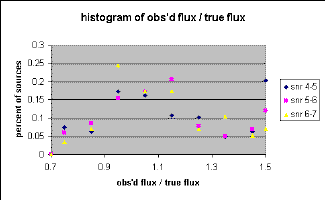 |
| Figure 3 |

|  |
| Figure 4 | Figure 5 |
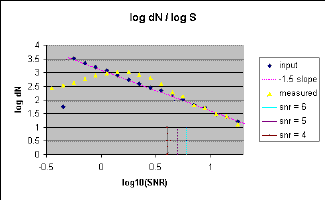
| 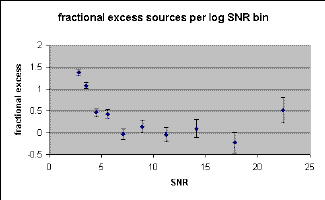 |
| Figure 6 | Figure 7 |
ii. Single Band vs. Multiband Thresholding
The above simulation was used to produce results for sources with the colors of galaxies. It was assumed that every single source had the following colors: J-H = 0.7 and H-Ks = 0.4. This is the "best case" for adding extra sources to the Catalog by a multiband rule. Normalizing to J, this translates into a typical SNR ratio of 0.69 for H/J and 0.55 for Ks/J.
The reason this is a "best case" can be seen by considering the other extreme of the bluest stellar colors: J-H = 0.2 and H-Ks = 0.05. Again, normalizing to J, this translates into a typical SNR ratio of 0.43 for H/J and 0.29 for Ks/J. With such lower SNR ratios at H and Ks, it makes it more unlikely for one of those bands to exceed any given threshold.
The simulation above was used to create the J population of sources, and then the "observed" H and Ks fluxes for those sources.
Although this may sound like it creates a bias in the simulation, the simulation procedure is actually exactly symmetric between the bands, since all sources have the same colors. For example, one can think of the process to generate a single source as simply generating a point in a "mythical SNR space" not connected to any band, and then scaling that mythical SNR space to the actual SNR of J, H and Ks, separately, using the fixed colors.
The derived log dN / log S, in Figure 8, shows the expected excess of sources starting at SNR ~ 6 in all bands. The number of sources is converging to almost the same level, independent of band at low SNR, since the number of observed SNR = 1 sources is dominated by sources boosted in flux by noise. Note that half of the simulated sources have SNR= 0.50 -- 0.79 at J and lower SNR at H and Ks, resulting in a slight excess of J sources, relative to H and Ks. If the simulation had gone down to SNR of 0.01 at J, the number of sources found at SNR = 1 would have been nearly identical in every band.
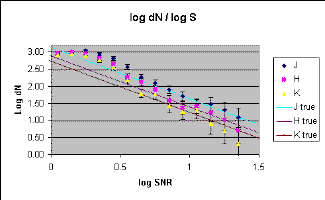 |
| Figure 8 |
Sources were selected for the "catalog" using two rules:
- SNR > 7 in a single band, resulting in 215 sources, all with J > 7;
and
- SNR > 6 in at least two bands. This added 9 sources:
- 1 with J, H, and Ks all > 6;
- 5 with J, H > 6;
- 2 with J, Ks > 6; and
- 1 with H, Ks > 6.
The nine added sources represents an increase of (4 ± 1)% in the number of sources in the "catalog." The reason for such a small number of sources is that a source with SNR = 7 at J has SNR = 4.8 at H and 3.8 at Ks. A source with SNR = 6 at J has SNR = 4.1 at H and 3.3 at Ks.
One can immediately see the source of the flux overestimation problem, detailed below at H and Ks, if a multiband threshold is used. If one uses only a single band threshold, sources are selected primarily, if not entirely, at J, and the H and Ks measurements are simply "carried along" and are unbiased. However, the additional sources selected from the multiband threshold have a serious flux overestimation problem. Only sources which have fluxes boosted by noise above SNR = 6, from their true fluxes of 4--5 at H and 3--4 at Ks, pass this multiband threshold.
Furthermore, note that the amount of flux overestimation using a multiband
threshold depends on the intrinsic flux of sources at those bands, relative to
a single band threshold. For example, for sources with highest SNR at J, the
J threshold implies H fluxes of SNR=4--5. Imposing a lower threshold at H
(which is what is effectively done by the multiband threshold), the flux
overestimation must be ~ 6 / (4--5), or 20--50%. Most of the sources will be
at the lower threshold of 20%, since it is harder for noise to boost a source
from 4 to 6  than from 5 to 6
than from 5 to 6  .
In the same way at Ks, the flux overestimation must be ~ 6 / (3--4),
or 50--100%, with most of the sources at 50%.
.
In the same way at Ks, the flux overestimation must be ~ 6 / (3--4),
or 50--100%, with most of the sources at 50%.
Figure 9 shows the J flux bias vs. J true flux, Figure 10 shows the H flux bias vs. H, and Figure 11 shows the Ks flux bias vs. Ks, where the flux bias is defined as the ratio of the observed flux to the true flux. In these figures, the sources selected from the multi-band rule are shown separately, with only the H thresholded sources shown on the H plot, and similarly for Ks. (In other words, the J diagram shows in a separate color only the eight additional sources which passed the SNR = 6 threshold at J, the H diagram shows the seven additional sources which passed the SNR = 6 threshold at H, and the Ks diagram shows the four additional sources above SNR = 6 at Ks.) The figures demonstrate:
- the expected J flux bias vs. J true flux, due to thresholding
(see below);
- the "filling in" of sources "missing" from the catalog, due to the single
band thresholding alone;
- the expected non-bias in the fluxes in bands that were
"carried along" by thresholding in another band; and,
- the expected severe bias in the fluxes in bands subjected to multi-band thresholding involving a given band.
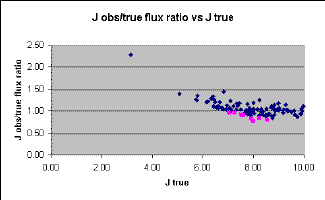
| 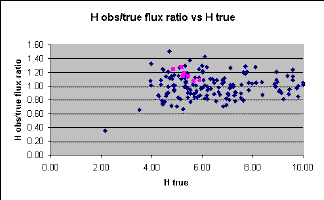
| 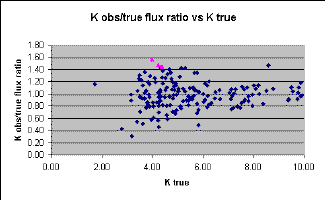 |
| Figure 9 | Figure 10 | Figure 11 |
The thresholding J bias is simple to understand. At Jtrue = 7,
only sources with positive noise excursions are allowed into the catalog by
the single band threshold. Hence, there must be a ~1  high bias in observed fluxes at whatever threshold is picked for the catalog.
At about 2
high bias in observed fluxes at whatever threshold is picked for the catalog.
At about 2  above the threshold, or SNR ~ 9, this
thresholding bias disappears. Below the threshold, the bias gets more severe.
The observed flux must be ~50% high at SNRtrue ~ 7/1.5 = 4.7, and a
factor of two high at SNR = 7/2 = 3.5, as observed.
above the threshold, or SNR ~ 9, this
thresholding bias disappears. Below the threshold, the bias gets more severe.
The observed flux must be ~50% high at SNRtrue ~ 7/1.5 = 4.7, and a
factor of two high at SNR = 7/2 = 3.5, as observed.
This bias is well known (see below for further discussion). If the noise distribution in a survey is understood, this bias can be statistically corrected. Furthermore, this bias is negligible above SNR = 10, so those sources can be used with confidence.
The single "outlier" point in all three figures above is a source with true
fluxes of (3.1, 2.2 and 1.7 mag) at (J, H and Ks), and observed
fluxes of (7.2, 0.8 and 2.0 mag). It is actually only an "outlier" at J,
having a 4.1  fluctuation upward. At H and
Ks, the fluctuations are -1.4 and +0.3
fluctuation upward. At H and
Ks, the fluctuations are -1.4 and +0.3  .
It looks like an outlier in the H and Ks diagrams only because the
source is a much weaker source than the others, and hence, its flux ratio and
H and Ks have large uncertainties.
.
It looks like an outlier in the H and Ks diagrams only because the
source is a much weaker source than the others, and hence, its flux ratio and
H and Ks have large uncertainties.
The "flip side" of the flux bias is, of course, the "missing" sources which were observed to fall below the threshold. Anything that is done to put fainter sources into the catalog will partially fill in some of the missing sources, such as observed here.
For sources selected by the single band rule, which essentially means a J selection for all sources outside highly-extincted areas, both H and Ks show an unbiased flux distribution down to the lowest fluxes for which there are large number of sources, SNR ~ 4 at H and ~3 at Ks. (Recall that below those levels the uncertainty grows rapidly, and hence there is no real constraint on the flux bias below those levels in this simulation.)
It is another story altogether for sources selected by the multiband rule. The mean flux bias at H is almost 20%, and at Ks is almost 50%, just as expected from the theoretical analysis above.
A multiband rule was not used for catalog source selection, because:
- A multiband rule creates a flux bias at H and Ks, where none
existed using the single band rule.
- The flux bias of the added sources is severe: 20 - 50% in this example,
and higher for sources with bluer colors.
- Having a multiband rule complicates the use of the catalog and makes it harder to derive corrections for any biases that result from what was done.
Since only 4% more sources were added as a result of the multiband rule, it the extra completeness is not worth the additional biases in the catalog. Note the statement above that "sources above SNR = 10 can be used with confidence." A corollary is that the "carry-along" bands can be used with confidence only as long as a multiband rule is not used.
iii. Catalog Selection By SNR, Not Flux Limits
The natural unit of any survey, such as 2MASS, is the noise (justified below). Magnitude or flux limits are fundamental measures for a source. But it is counterproductive, and often dangerous, if one uses a flux limit to select sources for entry into a catalog.
The definition of what the noise actually is in any survey must, of course, be carefully considered. However, for the moment, assume that one understands the noise in a given survey, and that its value is readily calculable.
The basic reason that catalog selection should be by SNR is that the value of
any experimental data depends strongly on its SNR. It is generally accepted
that for any individual source, nothing less than a 95 or 99% confidence limit
should be used to quote a meaningful number, corresponding to 2--3 Gaussian
 . It is also generally accepted that for any
survey containing lots of sources, no source that does not have at least one
measurement with flux above 5--6
. It is also generally accepted that for any
survey containing lots of sources, no source that does not have at least one
measurement with flux above 5--6  should enter a
catalog of results from that survey.
should enter a
catalog of results from that survey.
The first reason behind the higher threshold for a survey is the
reliability of the catalog based on the survey. The reliability depends
directly on the number of volume elements over which one searches for sources
in a survey. For example, if the survey makes independent estimates for every
4´´ × 4´´ area of sky, there are 3.3×1010
volume estimates in the sky. Even under Gaussian statistics, rarely attained
in any survey, a +5  fluctuation happens
3×10-7 for each volume element, and hence there would be
10,000 false sources in a catalog containing sources down to 5
fluctuation happens
3×10-7 for each volume element, and hence there would be
10,000 false sources in a catalog containing sources down to 5  .
.
In practice, there is a significant non-Gaussian tail in nearly all surveys,
which could easily produce 10--100 times more false sources above 5  ,
which would be 100,000 to 1 million false sources.
,
which would be 100,000 to 1 million false sources.
There are at least three other reasons why catalogs should not use a
threshold below 5-6  for a source to
enter the catalog:
for a source to
enter the catalog:
- The actual accuracy of the photometric measurement is much lower than is
commonly associated with a "5
 measurement";
measurement";
- there is a severe flux overestimation problem; and
- the quoted photometric error does not well describe the actual error distribution, which is severely non-Gaussian for fainter sources.
The basic problems here derive from the usual astronomical case that the number of sources increases rapidly as flux decreases.
Catalogs can and should contain fluxes that are carried along from
other bands that are well below 5--6  . Those
fluxes are largely unbiased, compared to the bands that have passed a threshold to enter the catalog. It is the act of thresholding that produces the bias, so
non-thresholded bands will not have the bias discussed here.
. Those
fluxes are largely unbiased, compared to the bands that have passed a threshold to enter the catalog. It is the act of thresholding that produces the bias, so
non-thresholded bands will not have the bias discussed here.
Consider all sources reported to be at a given flux of n  in a survey. They will consist of sources whose true flux is n
in a survey. They will consist of sources whose true flux is n
 and whose realized measurement error is zero, and
of sources whose true flux is n+m
and whose realized measurement error is zero, and
of sources whose true flux is n+m  whose realized measurement error is -m
whose realized measurement error is -m  .
When n is large, this population smearing matters little, since the
ratio of the true fluxes of these sources coming from the population with
realized measurement errors of +m and -m
.
When n is large, this population smearing matters little, since the
ratio of the true fluxes of these sources coming from the population with
realized measurement errors of +m and -m  is (n+m) / (n-m) ~ 1 + 2m/n.
Taking m=1, the ratio is 1 + 2/n, which is 1.2 for n=10
(1.22 non-approximated value). Note that the ratio goes to zero as n
increases, but becomes quite large as n decreases.
is (n+m) / (n-m) ~ 1 + 2m/n.
Taking m=1, the ratio is 1 + 2/n, which is 1.2 for n=10
(1.22 non-approximated value). Note that the ratio goes to zero as n
increases, but becomes quite large as n decreases.
In nearly all cases, the number of sources varies with flux, as flux to the
-1 or -1.5 power. Hence, the ratio of the number of true sources at
n+m  to the true number at
n-m
to the true number at
n-m  is
{(n+m)/(n-m)}(1 to 1.5).
For n=10 and m=1, this ratio is 1.22--1.35. For m=2,
the ratio is 1.5 - 1.8.
is
{(n+m)/(n-m)}(1 to 1.5).
For n=10 and m=1, this ratio is 1.22--1.35. For m=2,
the ratio is 1.5 - 1.8.
Hence, even at 10  , the error distribution is not
symmetric: there are 20--30% more sources whose true flux is 9
, the error distribution is not
symmetric: there are 20--30% more sources whose true flux is 9
 than those whose true flux is 11
than those whose true flux is 11
 , and 50--80% more sources whose true flux is 8
, and 50--80% more sources whose true flux is 8
 than those whose true flux is 12
than those whose true flux is 12
 . Note that as n increases, this effect
vanishes, and hence can be largely ignored for a catalog which contains only
sources brighter than SNR=10.
. Note that as n increases, this effect
vanishes, and hence can be largely ignored for a catalog which contains only
sources brighter than SNR=10.
However, as one goes below 10  , note what happens
to that ratio of the true fluxes of these sources. At 5
, note what happens
to that ratio of the true fluxes of these sources. At 5
 , the ratio is 6/4 -- 7/3 = 1.5 to 2.3, for
m=1 to 2. Hence, the observed 5
, the ratio is 6/4 -- 7/3 = 1.5 to 2.3, for
m=1 to 2. Hence, the observed 5  sources
come from sources whose true flux varies typically by 50%, compared to the
variation of 20% or less for the sources with SNR above 10.
sources
come from sources whose true flux varies typically by 50%, compared to the
variation of 20% or less for the sources with SNR above 10.
Worse, in this set of sources whose flux is claimed to be 5  ,
there are a lot more sources whose true flux is actually
3--4
,
there are a lot more sources whose true flux is actually
3--4  than whose true flux is actually
6--7
than whose true flux is actually
6--7  . The ratio of the number of sources whose
true flux is 3
. The ratio of the number of sources whose
true flux is 3 , compared to the number of sources
whose true flux is 5
, compared to the number of sources
whose true flux is 5 , is (5/3){1,1.5}
= 1.7 -- 2.2. This gives rise to a large number of problems:
, is (5/3){1,1.5}
= 1.7 -- 2.2. This gives rise to a large number of problems:
- There is a severe flux overestimation problem for sources below
5--6
 . A simple model shows that, under one set
of assumptions, the set of sources with quoted flux of 5
. A simple model shows that, under one set
of assumptions, the set of sources with quoted flux of 5
 actually have true fluxes of ~4.5
actually have true fluxes of ~4.5
 (the actual number depends strongly on a number
of factors, so this value should only be taken as showing a significant
difference from 5
(the actual number depends strongly on a number
of factors, so this value should only be taken as showing a significant
difference from 5  ). The flux overestimation
quickly gets worse at lower
). The flux overestimation
quickly gets worse at lower  . See the
IRAS Faint Source Catalog Explanatory Supplement for a
quantitative discussion of the flux overestimation problem.
. See the
IRAS Faint Source Catalog Explanatory Supplement for a
quantitative discussion of the flux overestimation problem.
- Note that the quoted photometric error does not well describe the
actual error distribution. The quoted photometric error usually derives
solely from the measurement error, which would be 20% at 5
 (1
(1  divided by
5
divided by
5  ). The actual photometric 1
). The actual photometric 1  error is larger, because the tail to low actual flux values has been
significantly increased.
error is larger, because the tail to low actual flux values has been
significantly increased.
- Furthermore, the distribution of actual photometric errors is quite
different from a Gaussian, even if the measurement error is Gaussian!
This is due to the larger number of true sources at fainter flux levels, and
would not be true if the number of sources vs. flux was constant.
- All of these problems result in a low accuracy of the photometric
measurement for these sources, much lower than what is commonly associated
with a "5
 measurement."
measurement."
All in all, this makes a catalog of sources almost begging to be
misused by most astronomers, if one includes sources fainter than
5--6  in all bands. (Again, catalogs
should contain measurements down to ~3--4
in all bands. (Again, catalogs
should contain measurements down to ~3--4  in
bands other than the band thresholded above 5--6
in
bands other than the band thresholded above 5--6
 .) Worse, because most of the sources in any
catalog are the faintest sources in the catalog, such problems quickly
adulterate any catalog that contains such faint sources.
.) Worse, because most of the sources in any
catalog are the faintest sources in the catalog, such problems quickly
adulterate any catalog that contains such faint sources.
This situation for a survey is completely different from the usual case
of a measurement for an individual source. If an astronomer already has a
source known from another survey, and wishes simply to obtain a flux
measurement for that source, a 5  measurement is
quite good. Concerns about flux overestimation play a much smaller factor,
since the source has already been selected. In other words, a random source
from a survey measured at 5
measurement is
quite good. Concerns about flux overestimation play a much smaller factor,
since the source has already been selected. In other words, a random source
from a survey measured at 5  is likely to be a
significantly fainter source, whereas a 5
is likely to be a
significantly fainter source, whereas a 5  measurement for a pre-detected source is likely to be an unbiased estimate of
the source's flux. This is why the measurements in bands carried along
after thresholding in another band also are valid measurements, not subject to
this thresholding bias.
measurement for a pre-detected source is likely to be an unbiased estimate of
the source's flux. This is why the measurements in bands carried along
after thresholding in another band also are valid measurements, not subject to
this thresholding bias.
Even a 5  measurement of a previously known
source at a different wavelength can easily be biased upward by
~1
measurement of a previously known
source at a different wavelength can easily be biased upward by
~1  , if care is not taken in how the flux
measurement is done. The bias arises if one attempts to measure the flux by
integrating until one gets a 5
, if care is not taken in how the flux
measurement is done. The bias arises if one attempts to measure the flux by
integrating until one gets a 5  measurement.
For example, if the true flux of the source is 5 mJy, it is more likely that
as the measurement converges, a 5-
measurement.
For example, if the true flux of the source is 5 mJy, it is more likely that
as the measurement converges, a 5- 6 mJy
measurement is obtained (which requires the uncertainty to be 1.2 mJy), before
a 5-
6 mJy
measurement is obtained (which requires the uncertainty to be 1.2 mJy), before
a 5- measurement at 5 mJy or 4 mJy. Hence, the
bias, which can be avoided by setting the integration time by some other means
than achieving exactly a specified signal-to-noise ratio.
measurement at 5 mJy or 4 mJy. Hence, the
bias, which can be avoided by setting the integration time by some other means
than achieving exactly a specified signal-to-noise ratio.
If you select a 5- detection in a given band, one
can argue that the source is "known," and that the measurements in the other
bands are unbiased. However, this is true only if one does not apply a
cut-off; if one require that those measurements also pass a threshold of some
sort, they will also be biased. This makes sense if one considers a
requirement that a 2-band detection be 5
detection in a given band, one
can argue that the source is "known," and that the measurements in the other
bands are unbiased. However, this is true only if one does not apply a
cut-off; if one require that those measurements also pass a threshold of some
sort, they will also be biased. This makes sense if one considers a
requirement that a 2-band detection be 5  in each
of two bands. The biases cannot change if one sorts first on the first band
and then on the second band, compared to the reverse.
in each
of two bands. The biases cannot change if one sorts first on the first band
and then on the second band, compared to the reverse.
Hence, special care must be taken putting sources into a catalog based on two bands satisfying a lower SNR threshold than source selection based on a single band. These sources are likely to have significantly increased flux overestimation.
The proper treatment of sources with no measurements above 5-6
 is to place them in a "Reject File." Astronomers
can use that "Reject File" to obtain quite valid measurements of individual
sources. Also, intrepid users who understand statistics and who can carefully
evaluate the actual error statistics of a catalog, may be able to use the
population of sources less than 5--6
is to place them in a "Reject File." Astronomers
can use that "Reject File" to obtain quite valid measurements of individual
sources. Also, intrepid users who understand statistics and who can carefully
evaluate the actual error statistics of a catalog, may be able to use the
population of sources less than 5--6  and reach
meaningful results. However, the history of such analysis is sordid, and
hence, making such users state that they analyzed the "Reject File" serves as
a warning to casual readers of their papers.
and reach
meaningful results. However, the history of such analysis is sordid, and
hence, making such users state that they analyzed the "Reject File" serves as
a warning to casual readers of their papers.
There is also a huge advantage to selecting sources by SNR. If a flux threshold is used to select sources, that flux threshold has to be set high enough, so that these problems do not exist in the least sensitive 2MASS scans. A SNR threshold takes advantage of the fact that many 2MASS scans are more sensitive than the worst scans, and releases a lot more useful sources to the community.
How To Select Sources By SNR
The SNR is the flux divided by the noise. The flux of a source is well defined. The flux of a point source is the PSF-fit flux in most cases, and the aperture flux in a few cases. Hence, the only concern is how to calculate the noise.
The prescription is simple: outside of high source density areas, the noise is directly related to the measured background. An extensive analysis of the noise shows that the typical residual between the measured background-removed noise and that predicted solely by the background is 0.02 DN. Hence, a robust estimate of the noise exists outside of high source density areas. In high source density areas, the measured Atlas Image noise can be used, either before or after background subtraction.
Of course, there are additional sources of noise: (1) meteor streaks, which
can occur by themselves, on top of faint point sources (making a 1
 true source into something much more), and can
cross another meteor streak; (2)
electronic noise; (3) airglow noise (both of which can interfere with
each other); (4) cosmic ray hits, hot pixels, pixels of varying noise;
and, (5) dead pixels that can occur anywhere on or in the background of a
source.
true source into something much more), and can
cross another meteor streak; (2)
electronic noise; (3) airglow noise (both of which can interfere with
each other); (4) cosmic ray hits, hot pixels, pixels of varying noise;
and, (5) dead pixels that can occur anywhere on or in the background of a
source.
None of these noise sources show up in gross measurements of the noise of an
entire Atlas Image, because they affect only a few pixels. Hence, these noise
sources are more properly considered as a cause of unreliable sources. The
distribution of these unreliable sources gives rise to a strong non-Gaussian
tail of sources that extends well beyond 5  , where
the
, where
the  is calculated from the background, which is
the same as the noise calculated from an individual Atlas Image.
is calculated from the background, which is
the same as the noise calculated from an individual Atlas Image.
The proper way to handle the presence of these noise sources is to empirically
study the reliability of the catalog as a function of SNR. It may well be
that one has to set the threshold well above 5--6  ,
in order to meet the point source reliability requirement. Thus, for point
sources, the SNR threshold should be set by the reliability requirement.
,
in order to meet the point source reliability requirement. Thus, for point
sources, the SNR threshold should be set by the reliability requirement.
The reliability requirement in the 2MASS Level 1 Specifications was placed on sources in the last half-magnitude bin above the SNR = 10 limit. The intent was that the faintest sources in the Catalog would satisfy that reliability requirement. In particular, note that one does not want searches for sources without optical identifications to be overwhelmed by false sources.
Because the "faintest sources in the Catalog" is not an easily quantifiable requirement, it is traditional to place the reliability specification at the SNR = 10 limit. The fundamental reason that the reliability standard must apply to all SNR levels in the Catalog is little attention is generally paid to what is the SNR of any source in a catalog. Putting sources into the Catalog that have significantly lower reliability than the SNR = 10 sources is the fastest route to adulterating the quality of the Catalog. In summary, a SNR threshold is mandatory for an optimal catalog.
[Last update: 1999 January 29, by T. Chester]
Return to V.3.